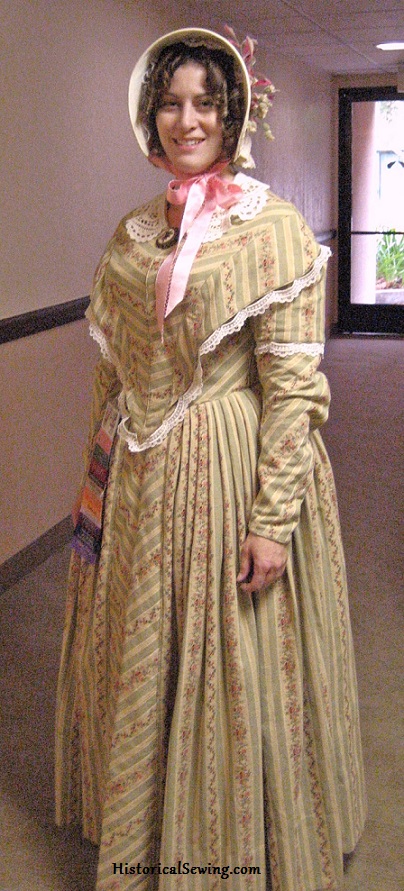
Many years ago (like, back in 2007 – why does that sound so long ago?!) I decided to make a 1840s dress for Costume College. The class track was The Crinoline Era so I needed a dress to go over my corded petticoat.
In stripes of course!
I found a fashion plate to copy, pulled out the relatively new pattern by Truly Victorian and set forth finding a way to match stripes easily. Here’s how that happened.
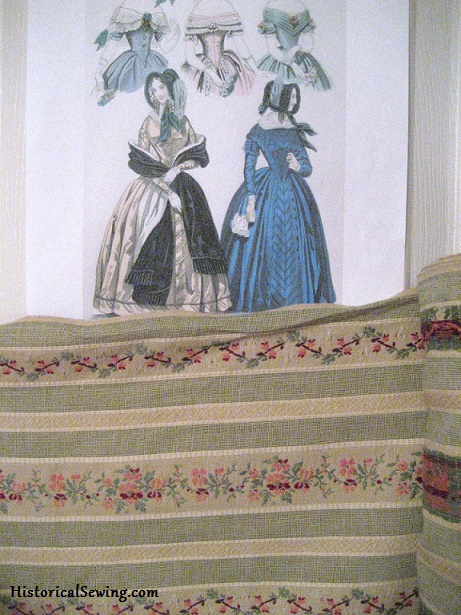
That blue dress had caught my eye for some time, and I was so excited to finally be able to reproduce it. But I had to remember that when following a fashion plate, the sketches are not drawn to human scale. No, the proportions are usually longer. So despite the ideal I was looking at I had to consider my own body shape when designing my mockup.
The fabric is 100% cotton that is similar to brocade in the way it is woven. It’s beautiful! And the swatch in the book felt light and fine for an Early Victorian dress. So yardage was ordered.
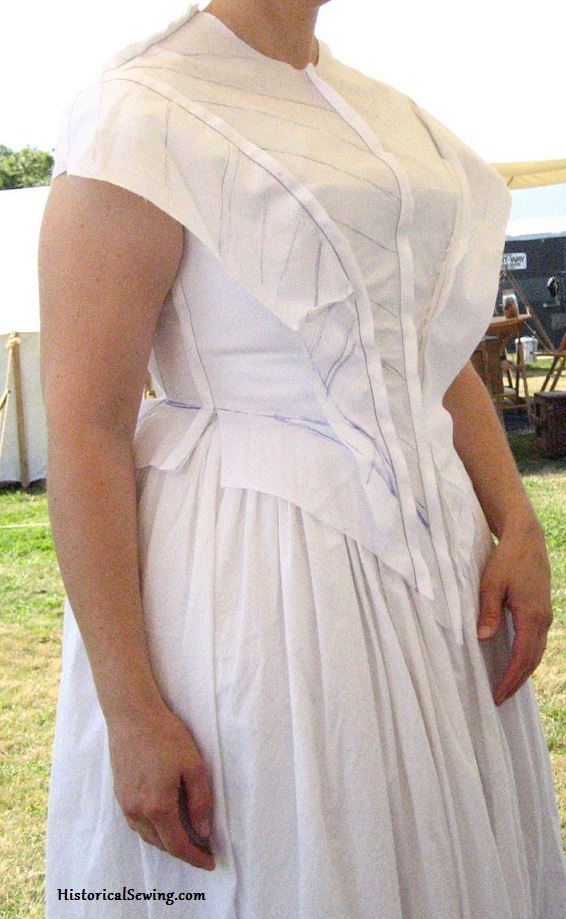
The bodice started from the Truly Victorian #454 1845 Day Dress pattern. I drew in the stripe lines on my mockup to match the fashion plate which is where I’ll match the pattern to the stripe grainline when cutting.
Because I changed the grain slightly from what the pattern listed I had to make two mockups – the first, straight from the pattern, and the second following my new grainlines to fine tune any areas. The bias front pieces were stabilized with on-grain pieces in the flatlining stage.
The pattern was quite long on me, especially around the hips and at the center front point. Whoa! You’d have to have a really long waist-to-hip torso to keep it that length and look good. You can see the line at my waist where I’m cutting it off – several inches!

This was my muslin carefully ripped apart so I could transfer the adjustments via needlepoint tracing wheel to my paper pattern. You can see that line again at the waist where I marked the bodice for shortening.
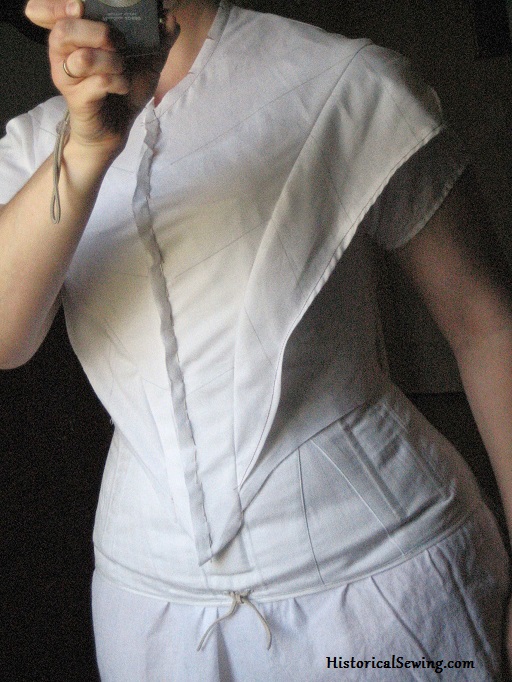
After I altered the pattern I sewed up a 2nd mockup. Fits much better!
On this mockup you can see that my bodice has the revere/side front seam going up to the shoulder point. This was the pattern and I didn’t feel like, nor have the time, to re-place the seamline to match the fashion plate. You can see in the plate below the side seam heads straight into the center of the shoulder.
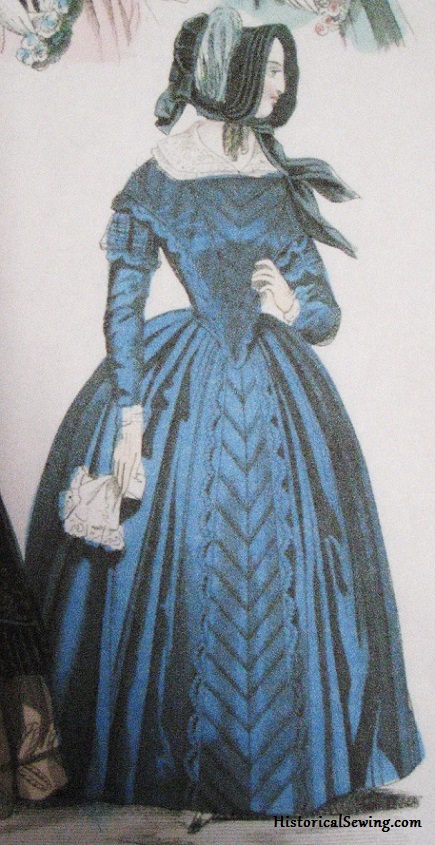
The revere comes down past my shoulder, limiting my movement, which is the style of the 1840s. Demure, pointing down, genteel, soft-spoken, non-assertive, etc…. (Little did I know that my fabric selection would make the whole sleeve area *thick* and make movement difficult.)
Cutting the dress took SO many more hours than I expected. It’s just a simple dress, right?
Well, yeah, until I realized that I needed to match my stripes – a one-directional, non-uniform stripe at that. Plus, I needed 325″ of bias to make piping. (Because just about every seam was piped in this era.)
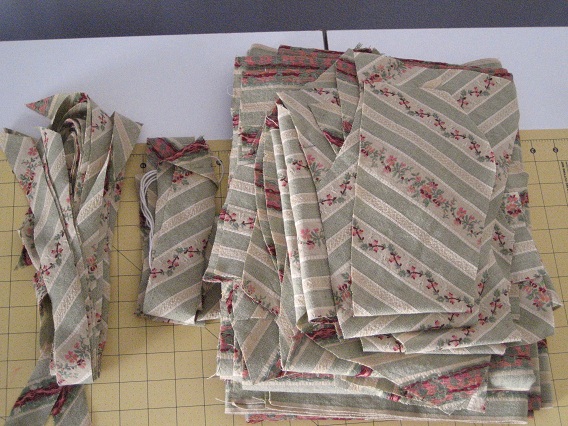
The bodice underlining was linen for a cooler summer dress while the skirt hem facing was plain muslin. Both were perfectly suited to my brocade cotton.
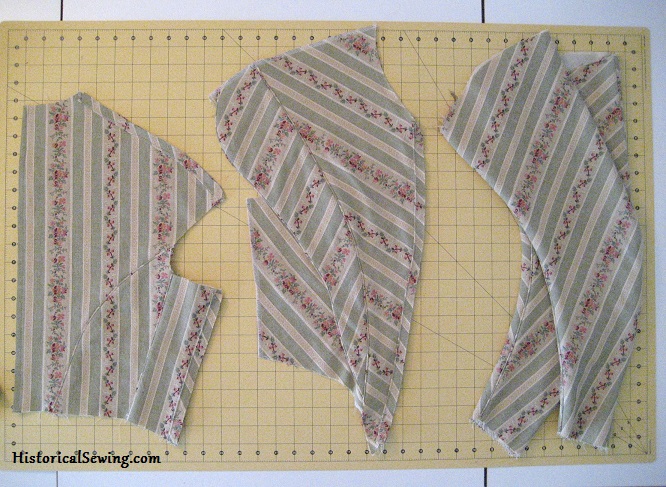
I really took my time cutting each piece separately to carefully match the stripes. Then I spent more cautious time when sewing. The stripe matching came out perfect though!
I decided to pipe every seam as was done in the 1840s. You can see the stripes on the back and side back section (on the left) line up even with the piping running along the seam. I decided to ignore my grainline (shock!) to allow for the stripe matching. The linen underlining, however, was cut on the grain for support.

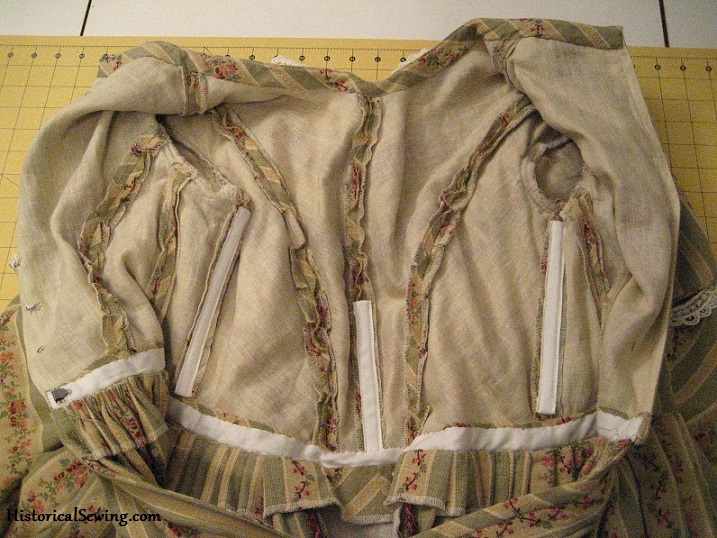
The bodice has only four bones: at the centers and one at each side seam. Because it is tightly fitted (bias cuts help with that) and the era doesn’t call for fully boned bodices, only those four bones were needed. The bodice closes in back with hook & thread loops while the collar is whipped around the piped neckline.

The main skirt panels were fairly straightforward. The center panel was cut on the bias for a chevron effect and piped at both sides – like the fashion plate! This is my favorite part of the entire dress!
The skirt center back was marked & sewn into cartridge pleats while the rest of it was knife pleated to fit the twill tape waistband. The band was then whipstitched to the inside of the bodice.
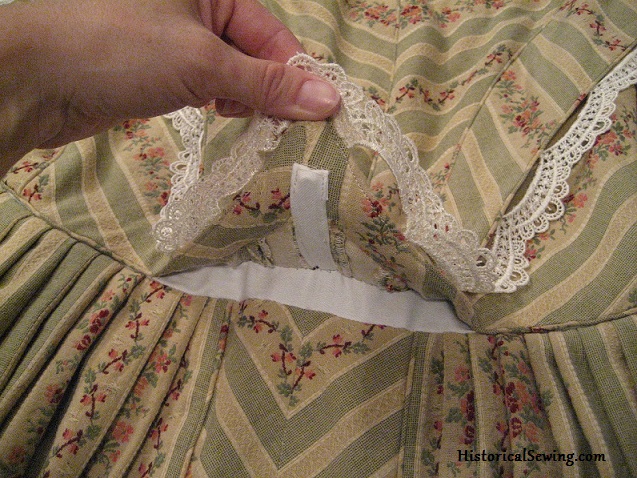
The wide hem facing was whipstitched down to the inside of the unlined skirt panels. Although – the bias panels were flatlined with muslin to support the bias.
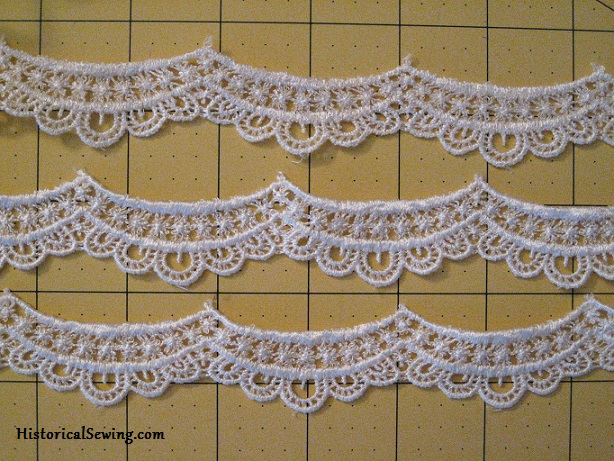
The lace was found on eBay and was already in ivory so I didn’t have to dye it (which is really terrific because dyeing anything scares the you-know-what out of me).
All those stripes needed something to break up the view. I think this lace was just the thing as it’s very similar to what is seen in the fashion plate.
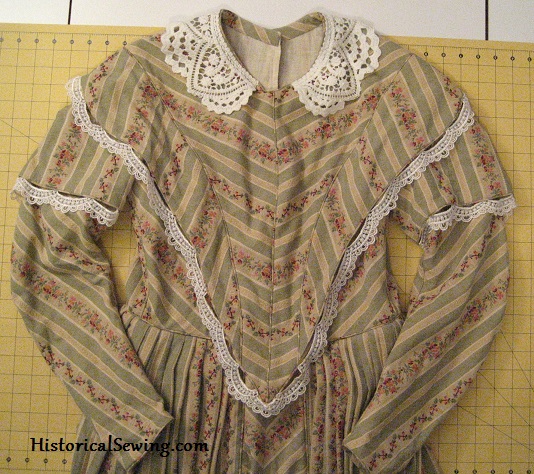
It was tacked along the reveres and the bottom of the sleeve jockeys (those short sleeves over the long ones). It was going to also go along the sides of the chevron skirt panel but, 1) I ran out of time, and 2) I felt it would be over-doing it. So I have a few yards of the stuff still in the stash for a later project.
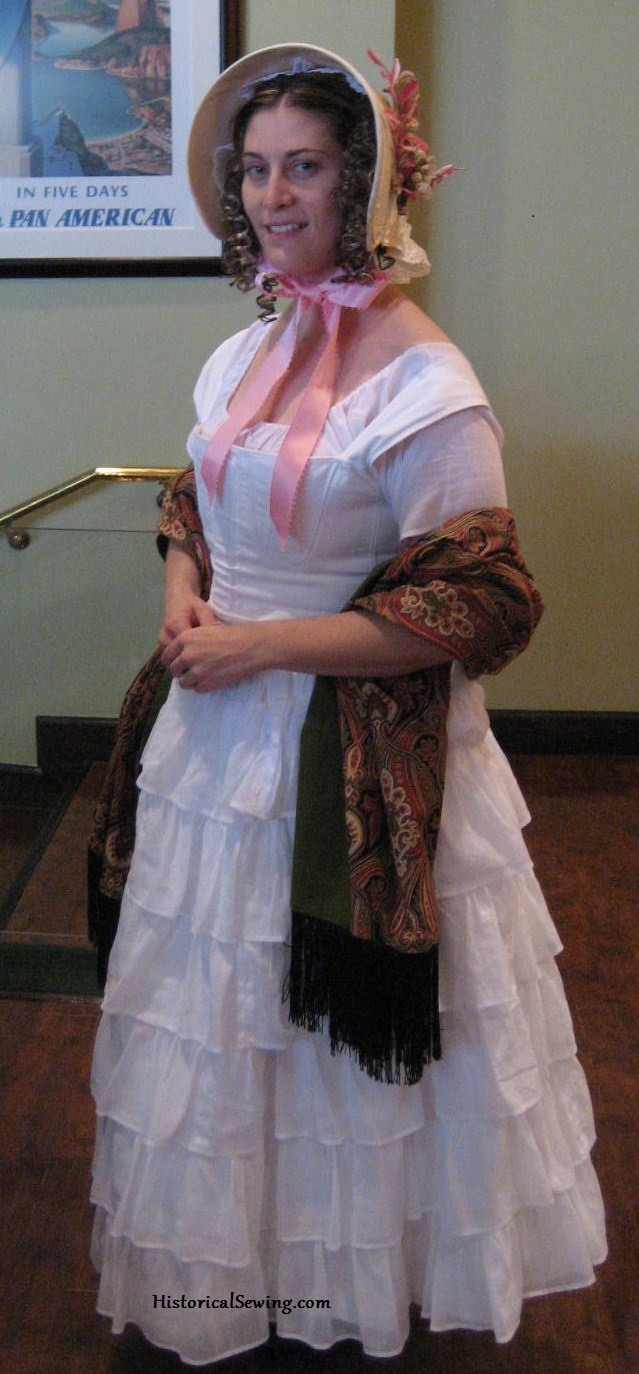
The silhouette was created with a boned & corded corset made from the Past Patterns #001 Corded Stays plus corded petticoat, and ruffled & plain petticoats.
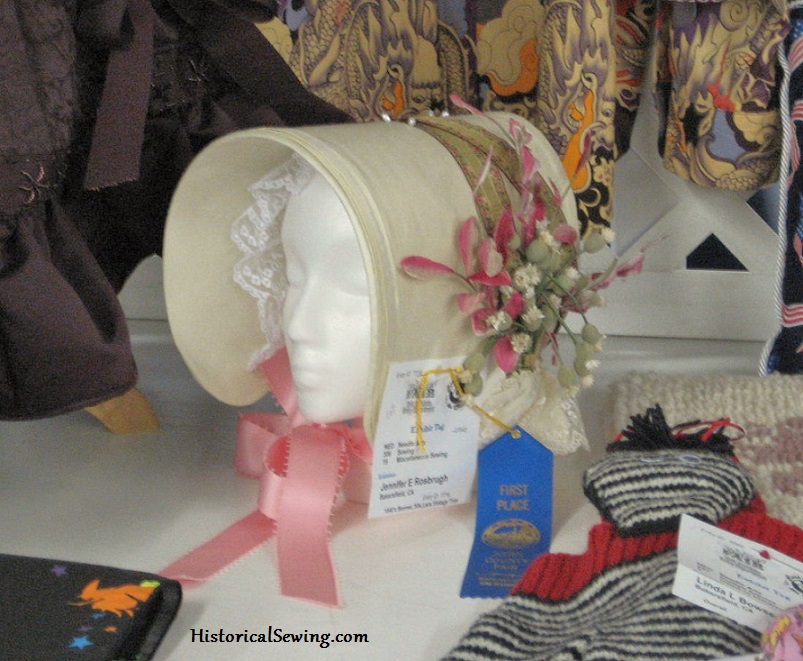
The yellow silk bonnet made from Miller’s Millinery #B3 1842-1849 Cottage Bonnet pattern and the quickly-sewn cotton paisley shawl were the finishing touches.
I think it’s time to go watch Jane Eyre again!

Thank you for this posting. I love the step by step photos. You did a great job explaining each step of your project. Love the strip placement on the front. This makes me want to improve my sewing techniques. I hadn’t thought about underlinings for support. Thank you!
Thank you for this wonderful post. It is so helpful to see the steps that bring a dress to life from a fashion illustration. No better “how to” ever!
What a beautiful dress! Working with all those stripes, you must have a lot of patience! Job well done!
Made a paisly like it but you are the master at constuction I look forward to taking on line class with you soon,thank you.
LOVE the fabric!!! Roses and dusky greens are my all time historical favorites.
I will be attempting a very basic striped Civil War day dress this year. It will be blue
and white with roses, all in narrow stripes. Your creation here served as some
good inspiration for me! Lovely dress, Jennifer. Also like the petticoat and bonnet!
Thanks for this very interesting post! The dress is lovely, and I enjoyed seeing how you made it. GREAT job with the stripes!